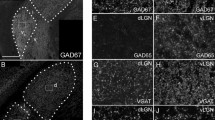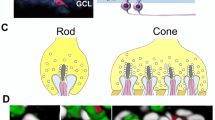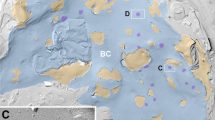Summary
The retinula cell axons entering the synaptic region of the optic lamina in the crayfish form large expanded bag-like terminals which are organized with other neural elements into structural units called ‘cartridges’. The cytoplasm of the terminals contains synaptic and coated vesicles, ER cisternae, clusters of tubular elements, and mitochondria. Several mitochondria are often found associated with a single large rod-shaped inclusion present within each terminal. The rod-like formation could be demonstrated in both light and EM material, it is composed of 85–95 Å filaments and averages I μm in width and 6.5 μm in length.
The terminal synaptic contacts are characterized by a bar-shaped presynaptic density and three postsynaptic elements. Some synaptic vesicles appear aligned along the bar density which measures approximately 800 Å in width and 0.75 μm in length. Each terminal synapse has three postsynaptic elements which have an electron-dense fringe along their membrane bordering the synaptic cleft. From the planes of section through this contact a composite reconstruction is presented.
Also present along the central border of the terminals are numerous small invaginated processes, some of which extend almost to the middle of the terminal. No membrane specializations were found along these processes and they have been tentatively identified as neuronal.
Similar content being viewed by others
References
Bernhard, H. (1916) Der Bau des Komplexauges von Astacus fiuviatilis (Potamobius astacus L.). Ein Beitrag zur Morphologie der Decapoden.Zeitschrift fuer Wissenschaftliche Zoologie 114, 650–707.
Boschek, C. B. (1971) On the fine structure of the peripheral retina and lamina ganglionaris of the fly (Musca domestica).Zeitschrift für Zellforschung und Mikroskopische Anatomie 118, 369–409.
Boycott, B. B. andDowling, J. E. (1969) Organization of the primate retina: light microscopy.Philosophical Transactions of the Royal Society of London Series B 255, 109–84.
Boycott, B. B., Gray, E. G. andGuillery, R. W. (1961) Synaptic structure and its alterations with environmental temperature: a study by light and electron microscopy of the central nervous system in lizards.Proceedings of the Royal Society of London Series B 154, 151–72.
Braitenberg, V. (1967) Patterns of projection in the visual system of the fly. I. Retina-lamina projections.Brain Research 3, 271–98.
Bunt, A. H. (1973) Paracrystalline inclusions in optic nerve terminals following intraocular injection of vinblastine.Brain Research 53, 29–39.
Coggeshall, R. E. andFawcett, D. W. (1964) The fine structure of the central nervous system of the leechHirudo medicinalis.Journal of Neurophysiology 27, 229–89.
Cuénod, M., Sandri, C. andAkert, K. (1972) Enlarged synaptic vesicles in optic nerve terminals induced by intraocular injection of colchicine.Brain Research 39, 285–96.
Dowling, J. E. andBoycott, B. B. (1965) Neural connections of the retina: fine structure of the inner plexiform layer.Cold Spring Harbor Symposium 30, 393–402.
Dowling, J. E. andBoycott, B. B. (1966) Organization of the primate retina: electron microscopy.Proceedings of the Royal Society of London Series B 166, 80–111.
Eakin, R. andBrandenburger, J. L. (1970) Osmic staining of amphibian and gastropod photoreceptors.Journal of Ultrastructure Research 30, 619–41.
Ebbesson, S. O. E. (1970) The selective silver-impregnation of degenerating axons and their synaptic endings in nonmammalian species. InContemporary Research Methods in Neuroanatomy (edited byNauta, W. J. H. andEbbesson, S. O. E.) pp. 132–61. New York: Springer-Verlag.
Eccles, J. C., Ito, M., andSzentágothai, J. (1967)The Cerebellum as a Neuronal Machine, Chapter VII, pp. 116–55. New York: Springer-Verlag.
Gray, E. G. andGuillery, R. W. (1963a) An electron microscopical study of the ventral nerve cord of the leech.Zeitschrift für Zellforschung and Mikroskopische Anatomie 60, 826–49.
Gray, E. G. andGuillery, R. W. (1963b) On nuclear structure in the ventral nerve cord of the leech (Hirudo medicinalis).Zeitschrift für Zellforschung und Mikroskopische Anatomie 59, 738–45.
Gray, E. G. andPease, H. L. (1971) On understanding the organization of the retinal receptor synapses.Brain Research 35, 1–15.
Gray, E. G. andWillis, R. A. (1970) On synaptic vesicles, complex vesicles and dense projections.Brain Research 24, 149–68.
Hafner, G. S. (1974) The neural organization of the lamina ganglionaris in the crayfish: A Golgi and EM study.Journal of Comparative Neurology 152, 255–80.
Hamóri, J. andHorridge, G. A. (1966a) The lobster optic lamina. I. General organization.Journal of Cell Science 1, 249–56.
Hamóri, J. andHorridge, G. A. (1966b) The lobster optic lamina. II. Types of synapse.Journal of Cell Science 1, 257–70.
Hamóri, J. andHorridge, G. A. (1966c) The lobster optic lamina. III. Degeneration of retinula cell endings.Journal of Cell Science 1, 271–4.
Hamóri, J. andHorridge, G. A. (1966d) The lobster optic lamina. IV. Glial cells.Journal of Cell Science 1, 275–80.
Heimer, L. (1969) Silver impregnation of degenerating axons and their terminals on Epon-Araldite sections.Brain Research 12, 246–9.
Heimer, L. (1970) Selective silver impregnation of degenerating axoplasm. In:Contemporary Research Methods in Neuroanatomy (edited byNauta, W. J. H. andEbbesson, S. O. E.) pp. 106–31. New York: Springer-Verlag.
Heuser, J. E. andReese, T. S. (1973) Evidence for recycling of synaptic vesicle membrane during transmitter release at the frog neuromuscular junction.Journal of Cell Biology 57, 315–444.
Iraldi, A. P. de andSuburo, A. M. (1971) Osmium tetroxide-zinc iodide reactive rites in the photoreceptor cells.Vision Research Supplement No. 3, 27–31.
Kanaseki, T. andKadota, K. (1969) The ‘vesicle in a basket’. A morphological study of the coated vesicle isolated from the nerve endings of the guinea pig brain with special reference to the mechanism of membrane movements.Journal of Cell Biology 42, 202–20.
Lovas, B. (1971) Tubular networks in the terminal endings of the visual receptor cells in the human, the monkey, the cat and the dog.Zeitschrift für Zellforschung und Mikroskopische Anatomie 121, 341–57.
Parker, G. H. (1897) The retina and optic ganglia in decapods, especially in Astacus.Mitteilungen aus der Zoologischen Station zu Neapel 12, 1–73.
Potter, H. D. (1973) Alterations in neurofibrillar rings in the lizard brain during cold acclimation.Journal of Neurocytology 2, 29–45.
Potter, H. D. andHafner, G. S. (1974) Sequence of changes in neurofibrils (neurofilaments) induced in synaptic regions of bullfrogs by environmental temperature changes. In preparation.
Reynolds, E. S. (1963) The use of lead citrate at high pH as an electron-opaque stain in electron microscopy.Journal of Cell Biology 17, 208–12.
Strausfeld, N. J. (1971) The organization of the insect visual system (light microscopy). I. Projections and arrangements of neurons in the lamina ganglionaris ofDiptera.Zeitschrift für Zellforschung und Mikroskopische Anatomie 121, 377–441.
Strausfeld, N. J. andBlest, A. D. (1970) Golgi studies on insects. Part I. The optic lobes of Lepidoptera.Philosophical Transactions of the Royal Society of London Series B 258, 81–134.
Szentägothai, J. (1970) The morphological identification of active synaptic regions: Aspects of general arrangement, of geometry and topology. In:Excitatory Synaptic Mechanisms (edited byAndersen, P. andJansen, J. K. S.) pp. 9–26. Oslo, Norway: Universitetsforlaget.
Trujillo-Cenóz, O. (1962) Some aspects of the structural organization of the arthropod ganglia.Zeitschrift für Zellforschung und Mikroskopische Anatomie 56, 649–82.
Trujillo-Cenóz, O. (1965). Some aspects of the structural organization of the intermediate retina of dipterans.Journal of Ultrastructure Research 13, 1–33.
Trujillo-Cenóz, O. (1972) The structural organization of the compound eye in insects. In:Physiology of Photoreceptor Organs. Handbook of Sensory Physiology, Vol. VII (edited byFuortes, M. G. F.) pp. 5–63. New York: Springer-Verlag.
Trujillo-Cenóz, O. andMelamed, J. (1973) The development of the retina-lamina complex in muscoid flies.Journal of Ultrastructure Research 42, 554–81.
Trujillo-Cenöz, O. andMelamed, J. (1963) On the fine structure of the photoreceptor-second order neuron synapse in the insect retina.Zeitschrift für Zellforschung und Mikroskopische Anatomie 59, 71–7.
Trujillo-Cenöz, O. andMelamed, J. (1967) The fine structure of the visual system ofLycosa (Araneae: Lycosidae). Part II. Primary visual centers.Zeitschrift für Zellforschung und Mikroskopische Anatomie 76, 377–88.
Van Harreveld, A. (1936) A physiological solution for fresh-water crustaceans.Proceedings of the Society for Experimental Biology 34, 428–32.
Viallanes, H. (1892) Contribution á l'histologie du systéme nerveux des invertébrés, La lame ganglionaire de la langouste.Annales des Sciences Naturelles Séries 7, Zoologie 13-14, 385–98.
Wolff, J. R. andGüldner, F. H. (1970) Über die Ultrastruktur des ‘Nervus opticus’ und des Ganglion opticum I vonDaphnia pulex.Zeitschrift für Zellforschung und Mikroskopische Anatomie 103, 526–43.
Yamada, E. (1965) Some observations on the membrane-limited structure within the retinal element. In:Intracellular Membranous Structure (edited bySeng, S. andCowdry, E. V.) pp. 49–63. Okayama Japan: Japanese Society of Cell Biology.
Author information
Authors and Affiliations
Rights and permissions
About this article
Cite this article
Hafner, G.S. The ultrastructure of retinula cell endings in the compound eye of the crayfish. J Neurocytol 3, 295–311 (1974). https://doi.org/10.1007/BF01097915
Received:
Revised:
Accepted:
Issue Date:
DOI: https://doi.org/10.1007/BF01097915




